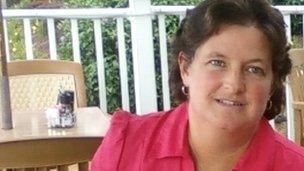Gene therapy 'gave me sight back'
- Published

Tami Morehouse: 'It's just incredible to see'
Three US citizens who lost their sight in childhood have reported a dramatic improvement in vision after having gene therapy in both eyes.
There was some improvement after the genetic fault in one eye was corrected four years ago.
Now, one woman has described her joy at seeing her children's faces, after her second eye was treated.
The research increases hopes that gene therapy can be used in a range of eye conditions, said a UK expert.
The three have Leber's Congenital Amaurosis (LCA), a rare inherited disease caused by defects in a gene encoding a protein needed for vision.
It appears at birth or in the first months of life, leading to severely impaired vision, involuntary eye movements and poor night vision.
The disorder, which can be caused by 'mistakes' in more than 10 different genes, prevents normal function of the retina; the light-sensitive layer of cells at the back of the eye.
Several teams around the world are carrying out early trials of gene therapy in blindness, including experts at the Philadelphia Children's Hospital and the University of Pennsylvania, US.
Only a handful of patients worldwide have received the treatment to boost a faulty gene underlying an inherited form of blindness.
Tami Morehouse on getting her sight back
The US researchers revealed in 2008 that 12 people with LCA had recovered some vision after being injected in one eye with an engineered virus carrying the gene RPE65.
In a follow-up study they treated the other eye of three of them, and found it improved their sight even more.
The subjects could see better in dim light and two were able to find their way around obstacles.
The results were revealed in the latest edition of the journal .
The principal investigator of the study, Dr Jean Bennett, said the patients could now do things they could never do before, such as walking around at night, going shopping for groceries and recognising people's faces.
She told the 大象传媒: "We've shown that it is possible to safely treat both eyes of people with this particular form of retinal deficiency using a gene-based treatment and further we've demonstrated that the brain understands what the retina is seeing."
MRI scans showed the brain could "see" the newly-treated eye.
Dr Manzar Ashtari, from The Children's Hospital of Philadelphia, who carried out the brain scans, told the 大象传媒: "We saw the brain gets activated - the brain after treatment responded to the visual stimuli."
'Incredibly valuable'
One of the three patients who took part in the clinical trial, Tami Morehouse, told the 大象传媒 how her vision gradually returned, opening up a whole new world for her.
Even though she can't see well enough to read or drive a car, she can now make-out her children's faces, watch them play baseball and see the light change over Lake Erie, where she lives.
She said: "Life is so much easier at a level that most people take for granted. Any amount of vision that you can get when you have almost nothing is incredibly valuable."
The researchers now hope to treat the second eye of the remaining nine patients, and extend the clinical trial.
Dr Bennett said: "I think it will be a stepping stone to treating more common forms of blindness in both eyes."
Commenting on the study, Clara Eaglen, policy and campaigns manager at the Royal National Institute of Blind People (RNIB), UK, said: "The early results of this small scale trial are encouraging, but clearly, a lot more research is needed to maximise the benefits of gene therapy techniques and understand how they can then be turned into effective treatments for a variety of more common degenerative eye conditions."
Professor Robin Ali of the Institute of Ophthalmology at University College London leads a UK team carrying out a similar trial of gene therapy.
He said: "This is confirmation that it is possible to administer gene therapy safely to the second eye of patients.
"This is reassuring and increases the prospect of this type of therapy for treatment of a wide range of eye conditions."
- Published27 October 2011
- Published13 October 2011